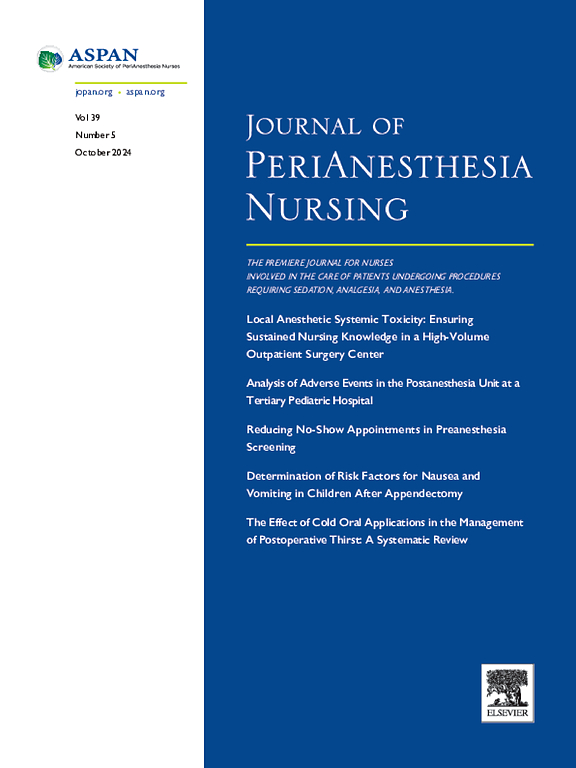使用腹横肌平面阻滞与鞘内吗啡进行剖宫产术后疼痛管理:系统回顾与元分析》。
IF 1.6
4区 医学
Q2 NURSING
引用次数: 0
摘要
目的:比较并评估腹横肌平面(TAP)阻滞与鞘内吗啡(ITM)对择期剖宫产术后疼痛、阿片类药物消耗及相关副作用的有效性:设计:系统回顾和荟萃分析:方法:在 PubMed、Google Scholar、CINAHL、Cochrane 协作数据库、UpToDate、Health Source 和灰色文献中进行证据检索。研究仅纳入了随机对照试验(RCT)。证据的方法学质量评估采用 "偏倚风险 "和 "推荐等级"、"评估"、"发展 "和 "评价 "系统进行。荟萃分析使用了综述管理器(RevMan 5.4,科克伦协作组织):共分析了 11 项 RCT,涉及 1,129 名患者。与 ITM 相比,TAP 对术后 48 小时内的静态疼痛评分(平均差 [MD];0.37;95% 置信区间 [CI],-0.04 至 0.79;P = .08)和动态疼痛评分(MD,0.43;95% 置信区间 [CI],-0.06 至 0.92;P = .09)具有相似的效果。此外,TAP阻滞术后恶心和呕吐的发生率较低(风险比为0.45;95% CI为0.31至0.66;P 结论:TAP阻滞术后恶心和呕吐的发生率较低:有证据表明,TAP阻滞在疼痛评分方面与 ITM 相当,在降低术后恶心和呕吐发生率方面更为有效,但 ITM 在减少术后阿片类药物用量方面更为有效。本文章由计算机程序翻译,如有差异,请以英文原文为准。
Postoperative Cesarean Section Pain Management Using Transversus Abdominis Plane Block Versus Intrathecal Morphine: A Systematic Review and Meta-analysis
Purpose
Compare and evaluate the effectiveness of transversus abdominis plane (TAP) block versus intrathecal morphine (ITM) on elective postcesarean section pain, opioid consumption, and related side effects.
Design
Systematic review and meta-analysis.
Methods
A search for evidence was conducted in PubMed, Google Scholar, CINAHL, Cochrane Collaboration Database, UpToDate, Health Source, and gray literature. Only randomized controlled trials (RCTs) were included in the study. The methodological quality of evidence assessment was conducted using the Risk of Bias and Grades of Recommendation, Assessment, Development, and Evaluation system. The meta-analysis used Review Manager (RevMan 5.4, The Cochrane Collaboration).
Findings
A total of 11 RCTs involving 1,129 patients were analyzed. Compared to ITM, TAP has a similar effect on static (mean difference [MD]; 0.37; 95% confidence interval [CI], −0.04 to 0.79; P = .08) and dynamic pain scores (MD, 0.43; 95% CI, −0.06 to 0.92; P = .09) within the first 48 hours after surgery. Additionally, the TAP block had a lower incidence of postoperative nausea and vomiting (risk ratio, 0.45; 95% CI, 0.31 to 0.66; P < .0001) and increased opioid consumption (MD, 6.78; 95% CI, 3.79 to 9.77; P < .00001). Overall, TAP block and ITM did not differ in the time to first to rescue analgesia, incidence of sedation, and pruritus.
Conclusions
Evidence suggests that TAP blocks are equivalent to ITM in pain scores and more effective at lowering the incidence of postoperative nausea and vomiting, yet ITM has been shown to be more effective in reducing postoperative opioid consumption.
求助全文
通过发布文献求助,成功后即可免费获取论文全文。
去求助
来源期刊

Journal of Perianesthesia Nursing
NURSING-
CiteScore
2.20
自引率
17.60%
发文量
279
审稿时长
90 days
期刊介绍:
The Journal of PeriAnesthesia Nursing provides original, peer-reviewed research for a primary audience that includes nurses in perianesthesia settings, including ambulatory surgery, preadmission testing, postanesthesia care (Phases I and II), extended observation, and pain management. The Journal provides a forum for sharing professional knowledge and experience relating to management, ethics, legislation, research, and other aspects of perianesthesia nursing.
 求助内容:
求助内容: 应助结果提醒方式:
应助结果提醒方式:


